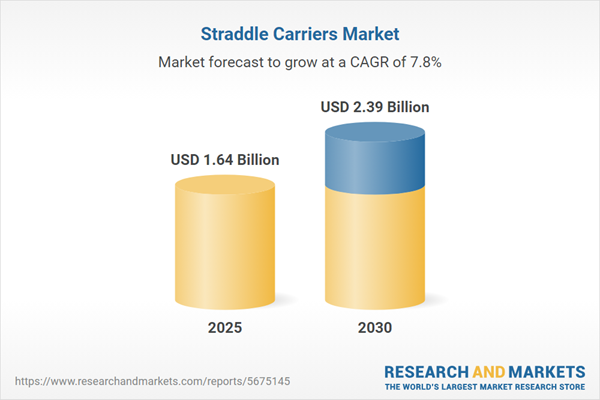Speak directly to the analyst to clarify any post sales queries you may have.
As global logistics networks intensify and technological innovation accelerates, senior leaders across ports, logistics, and manufacturing must re-examine their material handling strategies. The straddle carriers market has emerged as a focal point for operational efficiency, sustainability, and competitive adaptation, shaped by the need for adaptable, high-performance solutions in dynamic supply chain environments.
Market Snapshot: Straddle Carriers Market Size and Growth
The straddle carriers market grew from USD 1.52 billion in 2024 to USD 1.64 billion in 2025. Demonstrating strong momentum, it is projected to maintain a CAGR of 7.76%, with revenue reaching USD 2.39 billion by 2030. Escalating trade volumes and evolving container management challenges are fueling investment in advanced straddle carrier solutions worldwide.
Scope & Segmentation
This comprehensive analysis provides deep visibility into the straddle carriers market, covering core power sources, automation levels, stacking capabilities, tonnage, applications, end users, regional trends, and distribution strategies. The research examines recent technological, regulatory, and geopolitical developments to help stakeholders align operational objectives with market opportunities. Key segments include:
- Power Source: Diesel, Electric, Hybrid configurations.
- Automation: Automated and Manual system options.
- Stacking Layer: Models built for more than 2 layers, as well as up to 2-layer variants.
- Tonnage Capacity: Carriers for 31-50 tons, above 50 tons, and up to 30 tons handling requirements.
- Application: Integration in container terminals, intermodal yards, rail yards, shipyards, and warehouses.
- End Use Industry: Sectors such as building material and construction, logistics, and manufacturing.
- Distribution Channel: Direct sales channels, plus distributors and dealer networks.
- Regions: Americas (North America - United States, Canada, Mexico; Latin America - Brazil, Argentina, Chile, Colombia, Peru); Europe, Middle East & Africa (United Kingdom, Germany, France, Russia, Italy, Spain, Netherlands, Sweden, Poland, Switzerland, United Arab Emirates, Saudi Arabia, Qatar, Turkey, Israel, South Africa, Nigeria, Egypt, Kenya); Asia-Pacific (China, India, Japan, Australia, South Korea, Indonesia, Thailand, Malaysia, Singapore, Taiwan).
- Companies: Major firms profiled include ASCOM S.p.A., China Construction Machinery Import & Export Co., Ltd., Cimolai S.p.A., Combilift, COMTEC TCS Srl, Everest Engineering Equipment Pvt Ltd., Gerlinger Carrier, Great Lakes Power Companies, Huada Heavy Industry, Isoloader Australia Pty Ltd, Kalmar Corporation, Konecranes Oyj, Kress Corporation, Liebherr-International AG, Mobicon Systems, MORELLO GIOVANNI S.R.L., NRS AS, Shanghai Zhenhua Heavy Industries Company Limited, and Yuantai Crane.
Key Takeaways for Senior Decision-Makers
- Advancements in automation and electrification are redefining performance benchmarks and driving operational efficiency.
- Regulatory pressure on emissions and sustainability targets is accelerating adoption of electric and hybrid powertrains.
- Flexible fleet configurations support both high-throughput and lower-volume operations amid fluctuating trade and logistics demand.
- Technological integration, such as predictive maintenance and telematics, reduces downtime and informs real-time asset management.
- Regional market dynamics necessitate tailored procurement strategies and supply chain resilience, especially in response to external shocks.
- Strategic partnerships with technology and service providers strengthen competitive positioning and enable differentiated aftersales support.
Tariff Impact: Adjustments and Supply Chain Considerations
Recent tariff changes in the United States have translated into higher input costs for straddle carrier manufacturers and end users, impacting equipment sourcing and aftermarket pricing. Domestic assembly efforts and dual sourcing agreements are gaining traction as operators seek stability and cost management in the face of shifting trade policy and increased duties on steel, electronics, and battery components. Service contracts and inventory optimization have become critical levers for mitigating tariff-related cost pressures.
Methodology & Data Sources
The research leverages structured interviews with industry leaders, analysis of public and proprietary documents, peer-reviewed data triangulation, and expert panel validation. This approach provides a robust foundation for the insights and strategic recommendations presented throughout the report.
Why This Report Matters: Strategy, Opportunity, and Risk Management
- Guides C-suite and operational leaders in planning capital investments and technology transitions in the straddle carriers market.
- Delivers actionable intelligence for risk mitigation, market entry, and supply chain optimization.
- Informs decision-makers on changing regulatory requirements, disruptive technologies, and the evolving competitive landscape, supporting long-term value creation.
Conclusion
Elevated by new technologies and regional investment, the straddle carriers market is set for continued transformation. Leaders who act on these strategic insights will strengthen their competitive edge and operational resilience in a dynamic global environment.
Additional Product Information:
- Purchase of this report includes 1 year online access with quarterly updates.
- This report can be updated on request. Please contact our Customer Experience team using the Ask a Question widget on our website.
Table of Contents
3. Executive Summary
4. Market Overview
7. Cumulative Impact of Artificial Intelligence 2025
List of Figures
Samples

LOADING...
Companies Mentioned
The key companies profiled in this Straddle Carriers market report include:- ASCOM S.p.A.
- China Construction Machinery Import & Export Co., Ltd.
- Cimolai S.p.A.
- Combilift
- COMTEC TCS Srl
- Everest Engineering Equipment Pvt Ltd.
- Gerlinger Carrier
- Great Lakes Power Companies
- Huada Heavy Industry
- Isoloader Australia Pty Ltd
- Kalmar Corporation
- Konecranes Oyj
- Kress Corporation
- Liebherr-International AG
- Mobicon Systems
- MORELLO GIOVANNI S.R.L.
- NRS AS
- Shanghai Zhenhua Heavy Industries Company Limited
- Yuantai Crane
Table Information
| Report Attribute | Details |
|---|---|
| No. of Pages | 183 |
| Published | October 2025 |
| Forecast Period | 2025 - 2030 |
| Estimated Market Value ( USD | $ 1.64 Billion |
| Forecasted Market Value ( USD | $ 2.39 Billion |
| Compound Annual Growth Rate | 7.7% |
| Regions Covered | Global |
| No. of Companies Mentioned | 20 |









